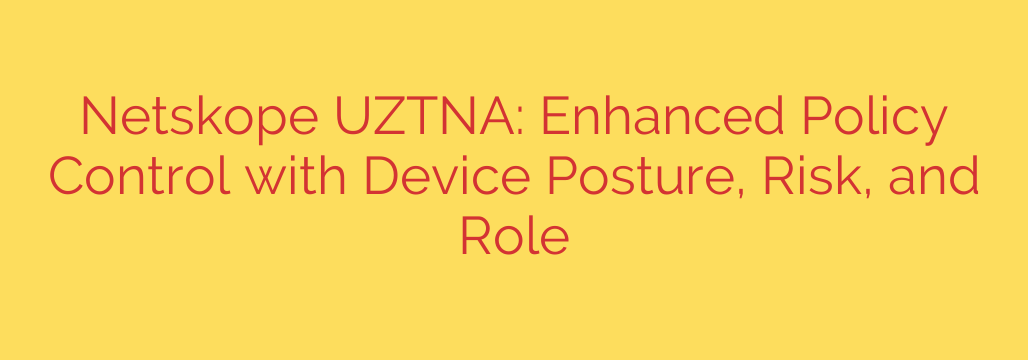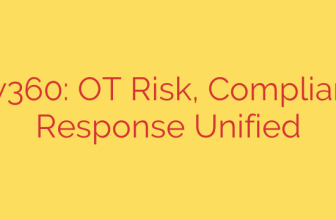
Beyond the Perimeter: Mastering Access Control with Zero Trust, Device Posture, and Risk Assessment
The traditional corporate network perimeter has dissolved. With the rise of remote work, cloud applications, and bring-your-own-device (BYOD) policies, the old model of a secure “castle” with a guarded “moat” is no longer effective. Today’s security challenges demand a more intelligent, granular, and adaptive approach. This is where a Zero Trust Network Access (ZTNA) framework becomes essential.
But not all ZTNA solutions are created equal. Basic ZTNA validates a user’s identity and grants them access to a specific application, which is a massive improvement over legacy VPNs that grant broad network access. However, true next-generation security requires digging deeper. To build a truly resilient security posture, organizations must integrate three critical pillars into their access policies: device posture, user risk, and user role.
What is Zero Trust Network Access (ZTNA)?
At its core, ZTNA operates on the principle of “never trust, always verify.” Instead of assuming that a user inside the network is safe, ZTNA treats every access request as a potential threat. It creates a secure, encrypted tunnel directly between an authenticated user and a specific application they are authorized to use.
Think of it this way: a VPN gives a user the keys to the entire office building, allowing them to wander into any room. ZTNA, on the other hand, gives a user a key that only opens the one specific office they need to be in, and only for the duration they need it. This dramatically reduces the attack surface and prevents lateral movement by bad actors.
Pillar 1: Device Posture — Is the Device Healthy?
Before granting access to corporate resources, you must first answer a fundamental question: is the device making the request secure? A verified user on a compromised or non-compliant device is a major security risk. This is where device posture assessment comes into play.
Device posture involves checking the security hygiene of the endpoint in real-time. A robust ZTNA policy should be able to verify critical attributes, including:
- Operating System Version: Is the OS up-to-date and patched against known vulnerabilities?
- Firewall Status: Is the device’s local firewall enabled and properly configured?
- Antivirus/Anti-malware: Is security software installed, running, and updated with the latest definitions?
- Disk Encryption: Is the device’s hard drive encrypted to protect data if lost or stolen?
- Specific Processes: Is a required security agent or application running on the device?
By continuously assessing device posture, you can create dynamic access policies. For example, a laptop with an outdated OS might be granted limited access to non-sensitive applications while being blocked from the company’s source code repository until it is patched. This ensures that only healthy, compliant devices can connect to your most critical assets.
Pillar 2: User and Device Risk — Is the Behavior Normal?
Device posture provides a static snapshot of device health, but it doesn’t tell the whole story. What if a compliant device is being used in a malicious way? This is where dynamic user and device risk assessment provides a crucial layer of context.
Modern security platforms can calculate a continuous risk score based on behavioral analytics and real-time threat intelligence. This allows the system to identify anomalous or suspicious activity that might indicate a compromised account or an insider threat. Factors that can influence a risk score include:
- Impossible Travel: A user logging in from New York and then from Tokyo just minutes later.
- Anomalous Access Patterns: A user from the finance department suddenly trying to access engineering servers at 3 AM.
- Unusual Data Movement: An endpoint suddenly attempting to upload gigabytes of data to a personal cloud storage account.
- Threat Intelligence: The device’s IP address is associated with a known botnet or malicious activity.
By incorporating a risk score into access policies, security becomes adaptive. If a user’s risk score suddenly spikes, the system can automatically respond by requiring multi-factor authentication (MFA), restricting access to sensitive data, or blocking the session entirely until the activity is reviewed by a security analyst.
Pillar 3: Role-Based Access Control (RBAC) — Who is the User?
The final pillar is based on the principle of least privilege: users should only have access to the information and systems absolutely necessary to perform their jobs. Role-Based Access Control (RBAC) is the mechanism for enforcing this.
By integrating with identity providers (like Okta, Azure AD, or Google Workspace), ZTNA can identify a user and their role within the organization. This allows for the creation of highly specific access policies.
- An engineer may be granted access to development servers and code repositories.
- A sales representative may have access to the CRM and sales enablement tools.
- A contractor may be given temporary access to a single, specific project management application.
Combining all three pillars is where the magic happens. An access policy can be defined like this: “Allow users from the ‘Engineering’ group (Role) to access the production database, but only if they are connecting from a device with disk encryption enabled (Posture) and their risk score is low (Risk).”
A Unified Strategy for Modern Security
Relying on just one of these pillars is not enough. A secure device can be used maliciously, a low-risk user may not be authorized for a specific application, and an authorized user on a compromised device is an open door for attackers.
By unifying device posture, user risk, and role-based controls within a single ZTNA framework, organizations can build a truly adaptive and context-aware security model. This approach moves beyond simple authentication and empowers you to grant access based on a holistic understanding of every connection request. In today’s hybrid work environment, adopting a comprehensive Zero Trust model isn’t just a best practice—it’s an operational necessity.
Source: https://www.helpnetsecurity.com/2025/10/08/netskope-uztna/







